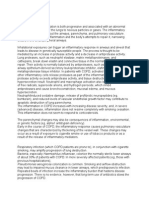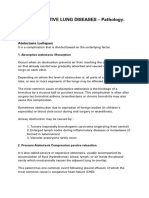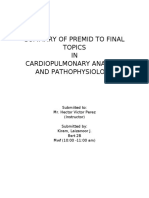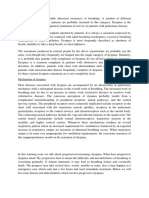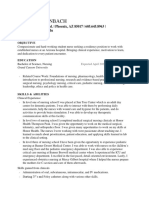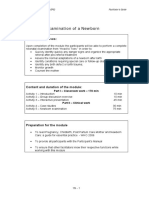Asthma, Airway Obstruction, Airway Hyperresponsiveness
Asthma, Airway Obstruction, Airway Hyperresponsiveness
Uploaded by
raissaCopyright:
Available Formats
Asthma, Airway Obstruction, Airway Hyperresponsiveness
Asthma, Airway Obstruction, Airway Hyperresponsiveness
Uploaded by
raissaOriginal Description:
Original Title
Copyright
Available Formats
Share this document
Did you find this document useful?
Is this content inappropriate?
Copyright:
Available Formats
Asthma, Airway Obstruction, Airway Hyperresponsiveness
Asthma, Airway Obstruction, Airway Hyperresponsiveness
Uploaded by
raissaCopyright:
Available Formats
ASTHMA, AIRWAY OBSTRUCTION, AIRWAY HYPERRESPONSIVENESS
Asthma
is a syndrome characterized by airflow obstruction that varies markedly, both spontaneously and with treatment.
Asthmatics have a special type of inflammation in the airways that makes them more responsive to those who are
nonasthmatics to a wide range of triggers, leading to excessive narrowing with consequent reduced airflow and
symptomatic wheezing and dyspnea.
Narrowing of airways is usually reversible, but in some patients with chronic asthma, there may be an element of
irreversible airflow obstruction
Airway Obstruction
is a blockage in the airway. It may partially or totally prevent air from getting into lungs.
Types:
Upper airway obstructions: area from nose and lips to larynx
Lower airway obstructions: larynx narrow passageways of lungs
Partial airway obstructions: allow some air to pass, still can breathe but difficult
Complete airway obstructions: dont allow any air to pass, cant breath
Acute airway obstructions: occur quickly. Ex. Choking on a foreign object
Chronic airway obstructions can occur in one of two ways, these can be blockages that take a long time to
develop or that last for a long time. Ex. Emphysema
Cause:
- inhaling or swallowing foreign object
- small object becoming lodged in the nose or mouth
- allergic reactions
- trauma to airway from an accident
- vocal cord problems
- infections
Airway Hyperresponsiveness
AHR is the characteristic physiologic abnormality of asthma and describes the excessive bronchoconstrictor
response to multiple inhaled triggers that would have no effect on normal airways. Increased bronchoconstrictor
responsiveness is seen with direct bronchoconstrictors such as histamine and methacholine, which contact
airway smooth muscle, but is characteristically also seen with many indirect stimuli, which release
bronchoconstrictors from mast cells or activate sensory nerves
Mechanism:
- Excessive contraction of the airway smooth muscle may result from increased volume and or contractility of
airway smooth muscle cells
- Uncoupling of airway contraction as a result of inflammatory changes in the airway contraction as a result of
inflammatory changes in the airway wall may lead to excessive narrowing of the airways and a loss of the
maximum plateu of contraction found in normal airways when bronchoconstrictor substances are inhaled
- Thickening of the airway wall by edema and structural changes amplifies airway narrowing due to contraction of
the airway smooth muscle for geometric reasons
-Sensory nerve may be sensitized by inflammation, leading to exaggerated bronchoconstriction in response to
sensory simuli.
You might also like
- Australian Medicines Handbook Pty LTDDocument5 pagesAustralian Medicines Handbook Pty LTDDia Sb75% (4)
- Pai 1Document6 pagesPai 1arieq bustamanNo ratings yet
- Submitted To DR Ritu Jindal Professor and Head of Dept Dept of Pedodontics and Preventive DentistryDocument43 pagesSubmitted To DR Ritu Jindal Professor and Head of Dept Dept of Pedodontics and Preventive Dentistrydr parveen bathlaNo ratings yet
- 1siras 1Document16 pages1siras 1Venkatesan VidhyaNo ratings yet
- Testing Visual Acuity With The Jaeger Eye ChartDocument2 pagesTesting Visual Acuity With The Jaeger Eye Chartaliextoma0% (1)
- Tracheostomy Care With ChecklistDocument5 pagesTracheostomy Care With ChecklistHollan Galicia100% (1)
- (Respi) Lo Week 2 Tutorial 1Document10 pages(Respi) Lo Week 2 Tutorial 1KintanNo ratings yet
- AsthmaDocument6 pagesAsthmaJay Hipulan QuiranteNo ratings yet
- SGD 910 Res 23Document15 pagesSGD 910 Res 23Zach ReyesNo ratings yet
- The Bronchial AsthmaDocument5 pagesThe Bronchial AsthmaKathleen Anne CajandingNo ratings yet
- AsthmaDocument46 pagesAsthmaHafiz Muhammad Aeymon100% (1)
- Copd 200412082048Document139 pagesCopd 200412082048Richard ArceNo ratings yet
- Bronchial Asthma: Mrs. Smitha. M Associate Professor Vijaya College of Nursing KottarakkaraDocument8 pagesBronchial Asthma: Mrs. Smitha. M Associate Professor Vijaya College of Nursing KottarakkaraSobha ajoNo ratings yet
- Obstructive Airways DiseaseDocument55 pagesObstructive Airways DiseaseSafiah JamaNo ratings yet
- Respi PathophysioDocument31 pagesRespi PathophysioIsmael JaaniNo ratings yet
- Obstructive Airway DiseasesDocument56 pagesObstructive Airway Diseaseskalanakariyawasam99No ratings yet
- Copd 1Document29 pagesCopd 1Maya NovikaNo ratings yet
- COPDDocument7 pagesCOPDarminmercado7406No ratings yet
- Asthm ADocument3 pagesAsthm ADebbi YuniseraniNo ratings yet
- COPD Pathophisiology NarrativeDocument3 pagesCOPD Pathophisiology NarrativejojrNo ratings yet
- He Cough Mechanism and The Function of The Cough ReflexDocument8 pagesHe Cough Mechanism and The Function of The Cough ReflexSasi KumarNo ratings yet
- Obstructive Lung Diseases - Slides English-1Document24 pagesObstructive Lung Diseases - Slides English-1Baqir BroNo ratings yet
- Patho Exam 3: Deficiency in Alpha-1-Antitrypsin-Unchecked Elastase Destruction of The AlveoliDocument5 pagesPatho Exam 3: Deficiency in Alpha-1-Antitrypsin-Unchecked Elastase Destruction of The AlveoliTaran LuthraNo ratings yet
- Onchi & CopdDocument8 pagesOnchi & CopdAngellene GraceNo ratings yet
- Diseases of The Respiratory System Diseases of The Respiratory System Principles of Respiratory InsufficiencyDocument9 pagesDiseases of The Respiratory System Diseases of The Respiratory System Principles of Respiratory InsufficiencyJaafar AlzuheiriNo ratings yet
- Asthma 1Document8 pagesAsthma 1Salman KhanNo ratings yet
- EMPHYSEMA NursingDocument35 pagesEMPHYSEMA NursingokaciaNo ratings yet
- Written Report: (Bronchial Asthma)Document8 pagesWritten Report: (Bronchial Asthma)Hannah SanchezNo ratings yet
- WhatDocument2 pagesWhatputeri_eda90No ratings yet
- Respiratory PathologyDocument26 pagesRespiratory PathologyIshali NuwanjiniNo ratings yet
- Asthma B-1Document2 pagesAsthma B-1JlopNo ratings yet
- CopdDocument4 pagesCopdapi-3739910100% (2)
- CR Patho SummaryDocument22 pagesCR Patho SummaryDNAANo ratings yet
- Pathophysiology of Asthma Trigger 1Document2 pagesPathophysiology of Asthma Trigger 1Amiraah MasriNo ratings yet
- EMPHYSEMADocument2 pagesEMPHYSEMAJerick DaangNo ratings yet
- Continuous Positive Airway Pressure: For EMT ProvidersDocument44 pagesContinuous Positive Airway Pressure: For EMT ProvidersYabetsNo ratings yet
- CopdDocument30 pagesCopdsalmanhabeebekNo ratings yet
- Homeopatija I AstmaDocument10 pagesHomeopatija I AstmaBranka PopovicNo ratings yet
- Bronchial AsthmaDocument45 pagesBronchial Asthmamuluken mulatieNo ratings yet
- Quiz Bank3Document5 pagesQuiz Bank3sunkislinNo ratings yet
- Asthma 1Document33 pagesAsthma 1Dalitso nkhomaNo ratings yet
- CopdDocument19 pagesCopdMuhammad IqbalNo ratings yet
- Dr. ChintanDocument26 pagesDr. ChintanArshad KhanNo ratings yet
- Lec.1 Obstructive Lung Diseases SaifDocument23 pagesLec.1 Obstructive Lung Diseases Saifs2111110520No ratings yet
- Oxygenation NotesDocument23 pagesOxygenation NoteschikaycNo ratings yet
- Anosmia: Total Loss of Olfactory (Smell) Sense,: Pharmacology & Therapeutics-II-406 (Theory) Spring 2019: DR Shah AJDocument4 pagesAnosmia: Total Loss of Olfactory (Smell) Sense,: Pharmacology & Therapeutics-II-406 (Theory) Spring 2019: DR Shah AJiqra sarwarNo ratings yet
- 5 Approach To The Patient With Disease of The Respiratory SystemDocument36 pages5 Approach To The Patient With Disease of The Respiratory SystemPhoebie Gael AsisNo ratings yet
- Pathology of The Respiratory System 2Document76 pagesPathology of The Respiratory System 2Fabian ChapimaNo ratings yet
- Airway ObstructionDocument4 pagesAirway ObstructionsakuraleeshaoranNo ratings yet
- AshtmaDocument95 pagesAshtmaObsa JemalNo ratings yet
- Bronchial AsthmaDocument34 pagesBronchial AsthmaFabb NelsonNo ratings yet
- Asthma Bahan Bacaan LengkapDocument18 pagesAsthma Bahan Bacaan LengkapBambang PutraNo ratings yet
- Resp Objectives Adn 253Document4 pagesResp Objectives Adn 253christian_zarate_2No ratings yet
- Chronic Obstructive Pulmonary DiseaseDocument10 pagesChronic Obstructive Pulmonary DiseaseZinya RobinsonNo ratings yet
- Articulo Parcial 1 Urgencias Respiratorias Perros y GatosDocument23 pagesArticulo Parcial 1 Urgencias Respiratorias Perros y GatosYara Valentina Toledo ManriqueNo ratings yet
- COPDDocument138 pagesCOPDMonique Reyes0% (1)
- Patho Respiratory - KatherineDocument9 pagesPatho Respiratory - KatherineKayla MayerNo ratings yet
- Normal Changes of AgingDocument9 pagesNormal Changes of AgingGiselle EstoquiaNo ratings yet
- Askep. B InggrisDocument10 pagesAskep. B InggrisSarni sarniNo ratings yet
- DASHBOARDDocument1 pageDASHBOARDGeraldine MaeNo ratings yet
- Dyspnea Is An Uncomfortable Abnormal Awareness of Breathing. A Number of DifferentDocument4 pagesDyspnea Is An Uncomfortable Abnormal Awareness of Breathing. A Number of DifferentSita SifanaNo ratings yet
- Physical Rehabilitation For Asthmatic PatientsDocument54 pagesPhysical Rehabilitation For Asthmatic PatientsIjeoma Okpalla60% (5)
- Pulmonary DiseasesDocument36 pagesPulmonary DiseasescelecosibNo ratings yet
- Vestil - Case Study On AsthmaDocument7 pagesVestil - Case Study On Asthmaninachristenevestil25No ratings yet
- Pre Term and Post Term Pregnancy ComplicationsDocument8 pagesPre Term and Post Term Pregnancy ComplicationsAbu YousufNo ratings yet
- Full Download Ballweg's Physician Assistant: A Guide To Clinical Practice 7th Edition Tamara S Ritsema PDFDocument64 pagesFull Download Ballweg's Physician Assistant: A Guide To Clinical Practice 7th Edition Tamara S Ritsema PDFpeliniliseby100% (4)
- Neonatal HypocalcemiaDocument5 pagesNeonatal HypocalcemiaLekshmi ManuNo ratings yet
- Case Study Presentation: Aravind Eye Care SystemDocument16 pagesCase Study Presentation: Aravind Eye Care SystemShiva Kumar 91No ratings yet
- Chapter 3 & 4Document8 pagesChapter 3 & 4Nurrita Adinda Anta PramuditaNo ratings yet
- EUROMEDLAB 2013 PostersDocument101 pagesEUROMEDLAB 2013 PostersidownloadbooksforstuNo ratings yet
- Diagnostic Tools in ImplantologyDocument143 pagesDiagnostic Tools in ImplantologyGaurav Issar100% (3)
- Clinical Survival Guide 2013 20141Document18 pagesClinical Survival Guide 2013 20141Noah ThomasNo ratings yet
- Intususepsi WindiDocument19 pagesIntususepsi WindikawaishoneNo ratings yet
- Ashley Odenbach Resume 9-2019Document2 pagesAshley Odenbach Resume 9-2019api-491453387No ratings yet
- Acute Chest Syndrome (ACS) CCGDocument11 pagesAcute Chest Syndrome (ACS) CCGJessa MaeNo ratings yet
- Dental Instrument ManualDocument45 pagesDental Instrument ManualRajah Kano50% (2)
- Clasp BDJDocument11 pagesClasp BDJAtiq RehmanNo ratings yet
- (FRCR) Sharma - Get Through FRCR Part 2B - Reporting of Plain RadiographsDocument249 pages(FRCR) Sharma - Get Through FRCR Part 2B - Reporting of Plain RadiographsPankaj Nagori100% (2)
- AnginheelDocument2 pagesAnginheelAyaNo ratings yet
- The Prevalence of Musculoskeletal Disorders and Their Association With Risk Factors in Auto Rickshaw Drivers - A Survey in Guntur CityDocument8 pagesThe Prevalence of Musculoskeletal Disorders and Their Association With Risk Factors in Auto Rickshaw Drivers - A Survey in Guntur CityijphyNo ratings yet
- Uia Teaching Hospital BriefDocument631 pagesUia Teaching Hospital Briefmelikeorgbraces100% (1)
- Newborn Assessment PDFDocument123 pagesNewborn Assessment PDFSarahNo ratings yet
- Kid's Health: Dr. John BergmanDocument39 pagesKid's Health: Dr. John BergmanAndrew FongNo ratings yet
- Acute Post-Streptococcal GlomerulonephritisDocument15 pagesAcute Post-Streptococcal GlomerulonephritisJeanne Marie ValesNo ratings yet
- MiliariaDocument2 pagesMiliariaperpesananNo ratings yet
- Organizational Chart4Document1 pageOrganizational Chart4api-3832358No ratings yet
- Manpreet Kaur.: Case PresentationDocument18 pagesManpreet Kaur.: Case PresentationDrGurinder KanwarNo ratings yet
- MEAD 2022 Workshop (Applicant)Document55 pagesMEAD 2022 Workshop (Applicant)hussain0% (1)



















